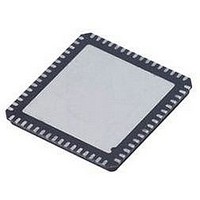AD9267BCPZ Analog Devices Inc, AD9267BCPZ Datasheet - Page 13

AD9267BCPZ
Manufacturer Part Number
AD9267BCPZ
Description
IC MOD SIGMA-DELTA DUAL 64LFCSP
Manufacturer
Analog Devices Inc
Datasheet
1.AD9267BCPZRL7.pdf
(24 pages)
Specifications of AD9267BCPZ
Applications
*
Mounting Type
Surface Mount
Package / Case
64-LFCSP
Resolution (bits)
16bit
Sampling Rate
640MSPS
Input Channel Type
Differential
Data Interface
Serial, SPI
Supply Voltage Range - Analog
1.7V To 1.9V
Supply Voltage Range - Digital
1.7V To 1.9V
Lead Free Status / RoHS Status
Lead free / RoHS Compliant
THEORY OF OPERATION
The AD9267 uses a continuous time Σ-Δ modulator to convert
the analog input to a digital word. The modulator consists of a
continuous time loop filter preceding a quantizer (see Figure 27),
which samples at f
pling ratio (OSR) of 32 for a 10 MHz input bandwidth. The output
of the quantizer is fed back to a DAC that ideally cancels the
input signal. The incomplete input cancellation residue is filtered
by the loop filter and is used to form the next quantizer sample.
The quantizer produces a nine-level digital word. The quantiza-
tion noise is spread uniformly over the Nyquist band (see
Figure 28) but the feedback loop causes the quantization noise
present in the nine-level output to have a nonuniform spectral
shape. This noise shaping technique (see Figure 29) pushes the
in-band noise out of band; therefore, the amount of quantiza-
tion noise in the frequency band of interest is minimal.
ANALOG INPUT CONSIDERATIONS
The continuous time modulator removes the need for an anti-
alias filter at the input to the AD9267. A discrete time converter
aliases signals around the sample clock frequency and its
multiples to the band of interest (see Figure 30). An external
antialias filter is needed to reject these signals.
BAND OF INTEREST
BAND OF INTEREST
DESIRED
INPUT
+
Figure 27. Σ-Δ Modulator Overview
Figure 30. Discrete Time Converter
MOD
–
Figure 28. Quantization Noise
UNDESIRED
Figure 29. Noise Shaping
= 640 MSPS. This produces an oversam-
QUANTIZATION NOISE
SIGNAL
LOOP FILTER
MODULATOR
f
S
NOISE SHAPING
H(f)
ADC
QUANTIZER
ADC
f
S
/2
f
f
MOD
MOD
/2
/2
Rev. 0 | Page 13 of 24
In contrast, the continuous time Σ-Δ modulator used within the
AD9267 has inherent antialiasing. The antialiasing property
results from sampling occurring at the output of the loop filter
(see Figure 31), and thus aliasing occurs at the same point in the
loop as quantization noise is injected; aliases are shaped by the
same mechanism as quantization noise. The quantization noise
transfer function, NTF(f), has zeros in the band of interest and
in all alias bands because NTF(f) is a discrete time transfer
function, whereas the loop filter transfer function, LF(f),
introduces poles only in the band of interest because LF(f) is a
continuous time transfer function. The signal transfer function,
being the product of NTF(f) and LF(f), only has zeros in all
alias bands and therefore suppresses all aliases.
Input Common Mode
The analog inputs of the AD9267 are not internally dc biased.
In ac-coupled applications, the user must provide this bias
externally. Setting the device such that V
recommended for optimum performance. The analog inputs
are 500 Ω resistors and the internal reference loop aims to
develop 0.5 V across each input resistor (see Figure 32). With
0 V differential input, the driver sources 1 mA into each
analog input.
2.3V
1.8V
1.3V
2.3V
1.8V
1.3V
INP UT
LOOP FILTER
LF(f)
H(z)
VIN+x
VIN–x
Figure 31. Continuous Time Converter
500Ω
500Ω
f
MOD
Figure 32. Input Common Mode
AVDD – 0.5V
QUANTIZATION
DAC
NOISE
OUTPUT
NTF(f)
L F (f)
CM
= AVDD is
TO LOOP FILTER
FROM QUANTIZER
STAGE 2
f
MOD
AD9267
f
MOD
f












